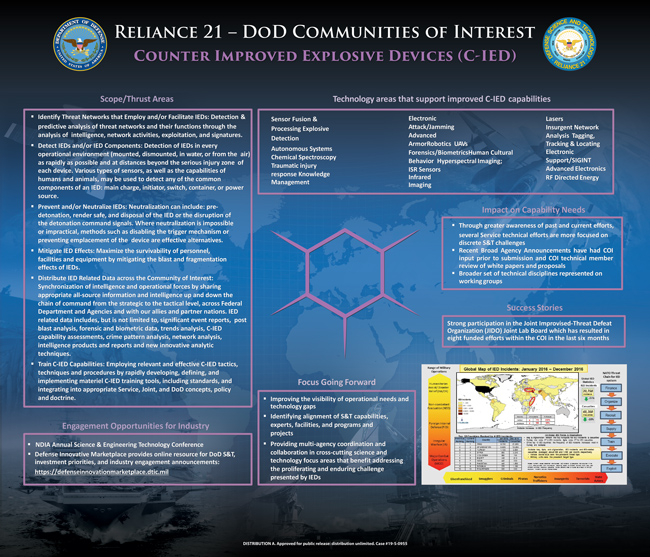Counter Improvised Explosive Devices (C-IED)
Communities of Interest - Alumni
- Identify Threat Networks that Employ or Facilitate IEDs: Detection & predictive analysis of threat networks and their functions through the analysis of intelligence, network activities, exploitation, and signatures.
- Detect IEDs and/or IED Components: Detection of IEDs in every operational environment (mounted, dismounted, in water, or from the air) as rapidly as possible and at distances beyond the serious injury zone of each device. Various types of sensors, as well as the capabilities of humans and animals, may be used to detect any of the common components of an IED: main charge, initiator, switch, container, or power source.
- Prevent and/or Neutralize IEDs: Neutralization can include: pre-detonation, render safe, and disposal of the IED or the disruption of the detonation command signals. Where neutralization is impossible or impractical, methods such as disabling the trigger mechanism or preventing emplacement of the device are effective alternatives.
- Mitigate IED Effects: Maximize the survivability of personnel, facilities and equipment by mitigating the blast and fragmentation effects of IEDs..
- Distribute IED-related Data across the CoIs: Synchronization of intelligence and operational forces by sharing appropriate all-source information and intelligence up and down the chain of command from the strategic to the tactical level, across Federal Department and Agencies and with our allies and partner nations. IED related data includes, but is not limited to, significant event reports, post blast analysis, forensic and biometric data, trends analysis, C-IED capability assessments, crime pattern analysis, network analysis, intelligence products and reports and new innovative analytic techniques.
- Train C-IED Capabilities: Employing relevant and effective C-IED tactics, techniques and procedures by rapidly developing, defining, and implementing materiel C-IED training tools, including standards, and integrating into appropriate Service, Joint, and DoD concepts, policy and doctrine.
